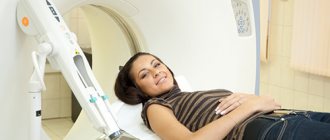According to established medical practice, the gynecologist determines the timing of pregnancy based on the first day of your last menstruation. According to this approach, the second week of pregnancy is a time of preparation for possible fertilization. By the end of the week, the egg is fully matured, so now is the easiest time to get pregnant.
If you follow the embryonic method, when the count is made from ovulation, then pregnancy 2 weeks after conception is the period when the fertilized egg has already attached to the wall of the uterus, that is, implantation has occurred.
What happens to the expectant mother
During the period of ovulation, a woman usually does not experience discomfort: menstrual pain and malaise have passed. But 2 weeks after conception, unusual sensations may occur:
- the breast becomes engorged, the sensitivity of the nipples increases;
- there is discomfort in the lower abdomen;
- may cause nausea, loss of appetite;
- irritability and mood swings occur;
- unusual reactions to familiar odors appear.
Such early signs of pregnancy in the 2nd week after conception and everything that a woman feels now is due to an increase in hCG levels. Its norm in the second week ranges from 50 to 500 mU/ml. Against this background, the pressure drops and you want to go to the toilet more often.
What will the study show at this time? Is it possible to see the embryo?
During an ultrasound for the above indications, a specialist may pay attention to the thickening of the endometrial layer, characteristic of 2 weeks of pregnancy. However, this sign is not diagnostically significant, since the endometrium thickens during the luteal phase, preparing the uterus for possible implantation of a blastocyst. Hyperplasia of the mucous layer is also observed in some pathological conditions, in particular with endometriosis.
It is impossible to see the embryo at this stage, even if the study is carried out in 3D or 4D mode, since it is tiny in size and cannot be visualized. Moreover, it is impossible to judge its development and condition. The most informative in this regard will be the first planned ultrasound at 11–14 obstetric weeks.
What happens to the embryo at 2 weeks
A child at 2 weeks of pregnancy is not yet a fetus, but only one small cell that has just attached to the endometrium and is beginning to rapidly grow and divide. A genome is formed inside it - biological information that will determine the external image and developmental characteristics of the unborn child.
If a malfunction occurs and the set of chromosomes turns out to be incorrect, the zygote will not be able to attach to the wall of the uterus and will leave the body along with uterine bleeding. This will be a normal menstruation for you, but this is how the natural mechanism of selecting viable cells works.
Let us repeat that all this applies to the embryonic method of calculating gestational age.
What happens after fertilization?
After fertilization has occurred, the hormonal levels in a woman’s body change dramatically. At the end of the third week of pregnancy, the fertilized egg attaches to the wall of the uterus. The implantation of the embryo may cause slight pain and may be accompanied by slight bleeding.
It is worth remembering that all of the listed symptoms are not accurate indicators of pregnancy. The same signs may indicate stress, overheating, and overwork. Therefore, there are no signs that guarantee the fact of conception.
Tests and ultrasound
There are no mandatory pregnancy tests in the second week. You need to wait 3-4 weeks before registration and a comprehensive examination. If the expectant mother wants to make sure her assumptions about pregnancy are correct, she can undergo testing using a pharmacy test or donate blood for hCG in the laboratory. The latter method, of course, is more accurate at such an early stage.
During an examination, an experienced gynecologist can assume the presence of pregnancy by assessing the slightly increased size of the uterus.
Is an ultrasound necessary?
If a woman is preparing to become a mother and is in the 2nd obstetric week of pregnancy, then with the help of ultrasound it is possible to determine the exact timing of ovulation, and therefore the optimal time for conception. Typically, such a study is resorted to for long-term reproductive problems.
At the 2nd embryonic week, ultrasound is not yet informative. The size of the fertilized egg is so small that an ultrasound cannot see what the embryo looks like. You will only notice a dark dot in the photo.
Changes in the female body and feelings of the expectant mother
Since the fertilized egg has virtually no connection with the mother’s body during the entire first week (it moves through the fallopian tube into the uterus), at the beginning of the second week the woman does not yet experience any special sensations. The size and shape of the abdomen do not change (can be seen in the photo), most expectant mothers do not feel that anything is happening to them.
In some women, implantation is accompanied by scanty spotting, lasting less than a day, and unexpressed uterine contractions. If a woman has a short menstrual cycle (for example, 21 days), she may notice a delay in her next period. Particularly sensitive women sometimes experience drowsiness, weakness, slight dizziness and nausea, and changes in the perception of smells. The expectant mother's immune system reduces its activity, preventing embryo rejection, so the woman becomes especially susceptible to viruses.
Problems
About 40% of early pregnancies end in miscarriage. In half the cases, the woman is not even aware of what has happened: menstruation may be delayed for a couple of days, and then bleeding will begin, perhaps more profusely than usual.
Another common complication is the threat of miscarriage. It can be suspected by sharp or nagging pain in the lower abdomen and bleeding. Some women note that they bleed a little, while others experience heavy blood loss. The condition is also accompanied by general malaise, dizziness and weakness.
A common cause of this is progesterone deficiency. But with timely consultation with a doctor, pregnancy can be maintained with the help of hormonal therapy.
Photo of ultrasound during pregnancy, photo of the fetus during ultrasound during pregnancy
4-5 weeks

The blood hCG level must be at least 1000 mU/ml. At this time, neither the embryo nor the yolk sac is visible. When two gestational sacs are visualized, it can be argued that this is a dichorionic multiple pregnancy. When visualizing one ovum, it can be stated that this is a monochorionic pregnancy. But at this stage we still cannot say how many embryos are in each fertilized egg. In addition, during a single ultrasound we cannot yet say whether this pregnancy is progressing, since the embryo does not yet have a heartbeat. The average internal diameter (ID) of the fetal egg at this stage is 2-10 mm. The conclusion will indicate: Short term intrauterine pregnancy.
Read more about ultrasound in early pregnancy
5-6 weeks

At this stage, a white ring appears inside the fetal egg - this is the yolk sac.
Foci of erythropoiesis form in the wall of the yolk sac, which form a capillary network, supplying erythroblasts (nuclear red blood cells) to the primary circulatory system of the fetus. The yolk sac is the source of primary germ cells that migrate from its wall to the gonads of the embryo. Until the 6th week after fertilization, the yolk sac, playing the role of the “primary liver,” produces many proteins important for the embryo - alpha-fetoprotein, transferrins, alpha2-microglobulin. By the end of the first trimester of pregnancy, this provisional organ ceases to function and is reduced.
The normal size of the yolk sac is 2-6 mm. If two yolk sacs are visualized in the fertilized egg, this means a monochorionic multiple pregnancy. But if one yolk sac is visible inside the fertilized egg, and the embryo is not yet clearly visualized, then it may still be monochorionic monoamniotic twins.
The embryo at the beginning of the 5th week is practically indistinguishable on the wall of the yolk sac, but by the end of the week the coccygeal-parietal size (CPR) of the embryo reaches 3 mm.
SVD of the ovum is 11-16 mm.
Do's and Don'ts
Paying close attention to yourself and your body’s needs will allow you to safely carry your baby without complications. Obviously, during pregnancy it is worth giving up smoking and alcohol, heavy physical and thermal stress, which increase uterine tone and lead to miscarriage. Avoid stressful situations. Taking any medications without a doctor's prescription can be dangerous for the unborn child. Be sure to tell the prescriber about your situation.
An expectant mother can and should eat a balanced diet, maintain physical activity, get enough sleep and proper rest, remain calm and have a positive attitude in any situation.
How to increase your chances of conceiving
If you are in your second obstetric week, follow a number of rules of intimate life that will help you get pregnant faster. A few days before expected ovulation, avoid physical intimacy to preserve and maintain sperm quality and motility.
After sexual intercourse, do not rush to get up: lie down for about 20 minutes, perhaps raising your legs or placing a pillow under your buttocks. This will help the sperm reach their goal faster.
And the most important condition is to get rid of internal worries, because the factor of psychological infertility occurs in 10% of cases. You will succeed!
What happens in a woman's body?
The production of hormones by the pituitary gland and ovaries regulates the release of the egg and initiates ovulation. At this time, vaginal discharge looks like egg white, transparent and viscous. They are called “cervical mucus.” It is this that facilitates the passage of sperm and their filtration.
After fertilization of the egg, this discharge will become transparent, less viscous, odorless and colorless, and will soon disappear. Successful ovulation will also be indicated by a sharp jump in basal temperature. Within 24 hours it will drop and return to the same level as before, or even increase.
Prenetics is a way to find out the risk of chromosomal abnormalities
already from the 10th obstetric week. Recommended for every pregnant woman. Duration of two days!
More details
Checklist 2 weeks pregnant
- Stock up on ovulation and pregnancy tests.
- 2 weeks after conception, undergo a blood test for hCG to be completely sure of the changes that have occurred.
- Change your lifestyle for the better: watch your diet, walk more, maintain a sleep-wake schedule.
- Remember to take 400 mcg of folic acid, unless otherwise prescribed by a specialist.
It doesn't matter how you count the weeks of pregnancy. Family planning and preparation for pregnancy require careful attention and a competent approach. The Women's Medical Center is pleased to offer you individual pregnancy planning and management programs at affordable prices.
What other symptoms does a woman experience in the second week?
- There may be an increase in libido, and the breasts begin to swell.
- Some women may experience changes in taste preferences, drowsiness and fatigue.
- Small rashes may appear on the face as a reaction to hormonal changes.
- Sometimes unpleasant sensations in the lower abdomen or nagging pain in the lower back are disturbing.
- A decrease in blood pressure is often observed.
- Urination may also become more frequent.
- And of course, the ovulation test will show a positive result.
These symptoms are typical for the second week of pregnancy, but are not at all mandatory for each individual woman.
Recommendations for future parents
General recommendations remain the same as in the first week:
- Give up bad habits, do not drink alcohol, eliminate smoking, even passive smoking. Avoid visiting places where there is smoke.
- Avoid lifting heavy objects to avoid causing a miscarriage.
- A woman needs to get enough sleep and proper rest, and spend more time in the fresh air.
- Do not visit crowded places or places where there is a risk of contracting an infection.
- Avoid X-ray examinations that are risky for the baby and uncontrolled use of medications.
- Eat properly and balanced.
If in three days, namely the life span of an unfertilized egg, it does not meet a sperm, then pregnancy will not occur in the current cycle. But if two eggs mature in the ovaries, even if the difference between them is several days, and both of them are fertilized, then the woman will give birth to fraternal twins.








